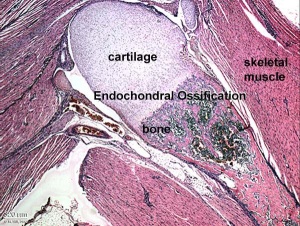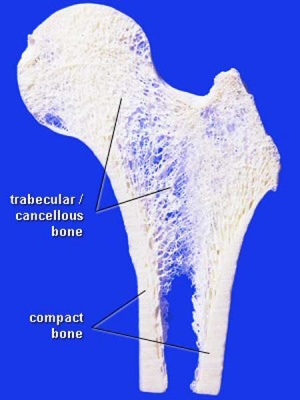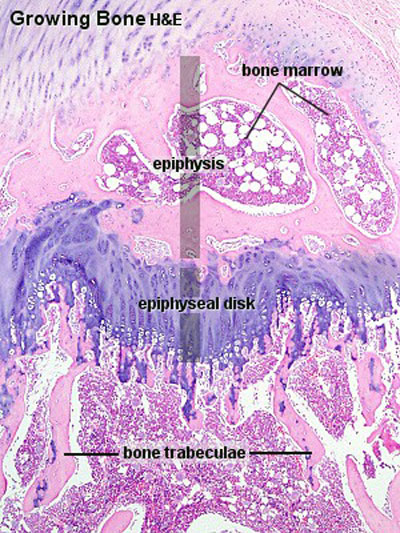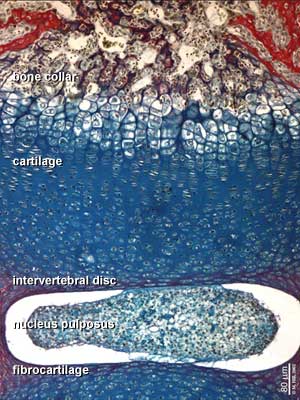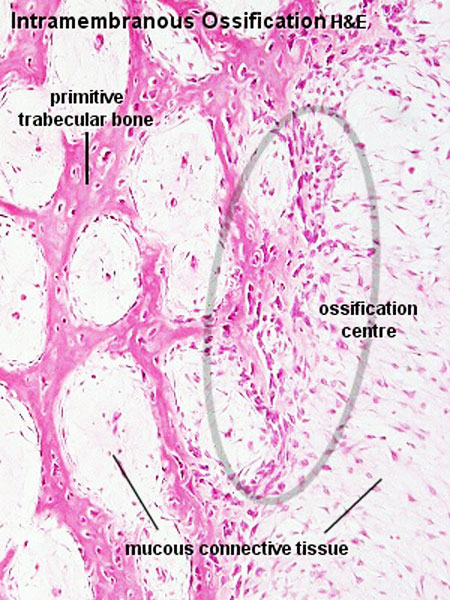Bone Development: Difference between revisions
No edit summary |
|||
| Line 16: | Line 16: | ||
# Endochondral ossification [http://vslide2.med.unsw.edu.au/slide.jsp?fn=histology/b12_40xr.fpx&mag=40 Developing bone] | [http://vslide2.med.unsw.edu.au/slide.jsp?fn=anatomy/ANAT6778.svs&mag=40 Bone, Developing (LS, Femur) Cat H&E] | # Endochondral ossification [http://vslide2.med.unsw.edu.au/slide.jsp?fn=histology/b12_40xr.fpx&mag=40 Developing bone] | [http://vslide2.med.unsw.edu.au/slide.jsp?fn=anatomy/ANAT6778.svs&mag=40 Bone, Developing (LS, Femur) Cat H&E] | ||
# Intramembranous ossification [http://vslide2.med.unsw.edu.au/slide.jsp?fn=anatomy/ANAT893.svs&mag=40&mag=40 Head (Neonatal) Rat H& Van Gieson] | # Intramembranous ossification [http://vslide2.med.unsw.edu.au/slide.jsp?fn=anatomy/ANAT893.svs&mag=40&mag=40 Head (Neonatal) Rat H& Van Gieson] | ||
== Bone Structure == | == Bone Structure == | ||
| Line 71: | Line 57: | ||
== Bone Matrix == | == Bone Matrix == | ||
The bone matrix has 2 major components. Organic portion composed of mainly collagen Type 1 (about 95%) and amorphous ground substance. Inorganic portion (50% dry weight of the matrix) composed of hydroxyapatite crystals, calcium, phosphorus, bicarbonate, nitrate, Mg, K, Na. ([http://images.google.com/images?rls=en-au&q=bone%20matrix Google- bone matrix images]) | The bone matrix has 2 major components. Organic portion composed of mainly collagen Type 1 (about 95%) and amorphous ground substance. Inorganic portion (50% dry weight of the matrix) composed of hydroxyapatite crystals, calcium, phosphorus, bicarbonate, nitrate, Mg, K, Na. ([http://images.google.com/images?rls=en-au&q=bone%20matrix Google- bone matrix images]) | ||
==Haversian Systems== | |||
[[File:Bone structure cartoon.jpg|thumb|Bone structure cartoon]] | |||
* also called osteons | |||
* Volkmann's canals - interconnect Haversian systems | |||
Lamellae | |||
* concentric - surrounding each Haversian System | |||
* interstitial - bony plates that fill in between the haversian systems. | |||
* circumferential - layers of bone that underlie the periosteum and endosteum | |||
Cells | |||
* osteocytes and canaliculi | |||
==Endochondral ossification== | ==Endochondral ossification== | ||
Revision as of 13:58, 21 September 2009
Introduction
Macroscopic and microscopic bone structure in the adult and during development.
For more development background see Science Lecture - Musculoskeletal Development
Textbook
Histology and Cell Biology: An Introduction to Pathology, A.L. Kierszenbaum, 2002 - Connective Tissue, Chapter 4 pp118-129; Osteogenesis, Chapter 5 pp131-145
Slides
UNSW Virtual Slidebox Virtual Slidebox Phase 1
- Compact Bone - Adult Bone , Adult (Ground, TS) Human Alizarin Red | Bone (Ground, LS) Human Alizarin Red
- Compact Bone Rib Decalcified rib, bone marrow
- Endochondral ossification Developing bone | Bone, Developing (LS, Femur) Cat H&E
- Intramembranous ossification Head (Neonatal) Rat H& Van Gieson
Bone Structure
Compact bone
- no spaces or hollows in the bone matrix visible to the eye.
- forms the thick-walled tube of the shaft (or diaphysis) of long bones, which surrounds the marrow cavity (or medullary cavity). A thin layer of compact bone also covers the epiphyses of long bones.
Trabecular bone
- (cancellous or spongy bone) consists of delicate bars (spicules) and sheets of bone, trabeculae
- branch and intersect to form a sponge-like network
- ends of long bones (or epiphyses) consist mainly of trabecular bone.
Periosteum
Connective tissue covering surface of bone.
Endosteum
Connective tissue lining inner surface of bone.
Bone Cells
Osteocytes
- mature bone-forming cells embedded in bone matrix
- derive from osteogenic stem cells forming Osteoblasts
- line surface of bone, secrete organic matrix of bone (osteoid), converted into osteocytes when become embedded in matrix (which calcifies soon after deposition) (Google- osteoblast images)
Osteoclasts
- bone-resorbing multinucleated macrophage-like cells
- origin- fusion of monocytes or macrophages, Blood macrophage precursor, Attach to bone matrix
- seal a small segment of extracellular space (between plasma membrane and bone surface), HCl secreted into this space by osteoclasts dissolves calcium phosphate crystals (give bone rigidity and strength) (Google- osteoclast images)
- do not mistake for megakaryocytes, found in bone marrow not associated with bone matrix.
- megakaryocytes are also multi-niucleated and form platelets
Bone Matrix
The bone matrix has 2 major components. Organic portion composed of mainly collagen Type 1 (about 95%) and amorphous ground substance. Inorganic portion (50% dry weight of the matrix) composed of hydroxyapatite crystals, calcium, phosphorus, bicarbonate, nitrate, Mg, K, Na. (Google- bone matrix images)
Haversian Systems
- also called osteons
- Volkmann's canals - interconnect Haversian systems
Lamellae
- concentric - surrounding each Haversian System
- interstitial - bony plates that fill in between the haversian systems.
- circumferential - layers of bone that underlie the periosteum and endosteum
Cells
- osteocytes and canaliculi
Endochondral ossification
Endochondral ossification slides Developing bone | Bone, Developing (LS, Femur) Cat H&E
Intramembranous ossification
Histology Stains
Alizarin Red
- an anthraquinone derivative used to identify calcium in tissue sections
- calcium forms an Alizarin Red S-calcium complex in a chelation process and the end product is also birefringent.
- reaction can also identify magnesium, manganese, barium, strontium, and iron may interfere
- these elements usually in too low concentration to interfere with the staining
H&E
- acronym for hematoxylin and eosin stain
- hematoxylin - basic dye which colors basophilic structures with blue-purple hue (nucleus, DNA, RNA)
- eosin Y - acidic alcohol-based which colors eosinophilic structures bright pink (cytoplasm, extracellular matrix, protein)
Links
- Original class notes
- UNSW Virtual Slidebox Virtual Slidebox Phase 1
- Virtual Slidebox of Histology (USA) Skeletal system
- Lecture - Musculoskeletal Development
Other Textbooks
- Anatomy of the Human Body (H. Gray, 1918.) historical anatomy text Osteology
- Molecular Biology of the Cell Bone Is Continually Remodeled by the Cells Within ItImage: Figure 22-52. Deposition of bone matrix by osteoblasts.Image: Figure 22-56. The development of a long bone.
- Molecular Cell Biology Mutations in Collagen Reveal Aspects of Its Structure and Biosynthesis
- The Cell- A Molecular Approach Steroid Hormones and the Steroid Receptor Superfamily
- Clinical Methods: The History, Physical, and Laboratory Examinations 100. Alkaline Phosphatase and Gamma Glutamyltransferase
- Endocrinology: An Integrated Approach by Nussey, S.S. and Whitehead, S.A. Endocrinology: Definition and causes of osteoporosis
- Developmental Biology 6th ed. by Gilbert, Scott F. Aging: The Biology of Senescence
